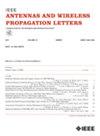A Steerable Dual-Polarized Monopulse Reflector Antenna With Gap-Waveguide Adaptive Phase Shifters for E-Band Backhaul
IF 4.8
2区 计算机科学
Q2 ENGINEERING, ELECTRICAL & ELECTRONIC
引用次数: 0
Abstract
This letter presents an E-band monopulse feed with broadband gap-waveguide adaptive phase shifters for Gregorian reflector antennas tailored for 5G backhaul communications. The monopulse functionality is achieved using a gap-waveguide-based一种用于e波段回程的带间隙波导自适应移相器的可操纵双偏振单脉冲反射天线
这封信介绍了一种e波段单脉冲馈源,带有宽带间隙波导自适应移相器,用于为5G回程通信量身定制的格里高利反射器天线。单脉冲功能是使用基于间隙波导的$2\ × 2$阶跃喇叭阵列馈电实现的,馈电网络包括3db耦合器和自适应移相器。该天线通过将馈电与格里高利反射器天线集成,实现了50 dBi的超高增益,并通过抵消子反射器焦点的馈电来实现波束控制。然而,在差分($\Delta$)模式中,馈送偏移会降低空深度。因此,提出了一种新的相位补偿策略,利用基于GRASP和CST仿真数据量化的数值相位补偿函数,将自适应移相器与偏移量协同设计。该天线在71 GHz至86 GHz的极化范围内的反射系数低于$-10$ dB。测量的辐射模式和增益与模拟结果非常接近。该系统的最大增益为50.48 dBi,波束转向距轴向误差在$\pm 2^\circ$内,最大转向损耗为0.96 dB。所有$\Delta$-波束的零深度都保持在20 dB以上。这些结果突出了该天线在5G回程通信中的巨大潜力。
本文章由计算机程序翻译,如有差异,请以英文原文为准。
求助全文
约1分钟内获得全文
求助全文
来源期刊
CiteScore
8.00
自引率
9.50%
发文量
529
审稿时长
1.0 months
期刊介绍:
IEEE Antennas and Wireless Propagation Letters (AWP Letters) is devoted to the rapid electronic publication of short manuscripts in the technical areas of Antennas and Wireless Propagation. These are areas of competence for the IEEE Antennas and Propagation Society (AP-S). AWPL aims to be one of the "fastest" journals among IEEE publications. This means that for papers that are eventually accepted, it is intended that an author may expect his or her paper to appear in IEEE Xplore, on average, around two months after submission.

 求助内容:
求助内容: 应助结果提醒方式:
应助结果提醒方式:


